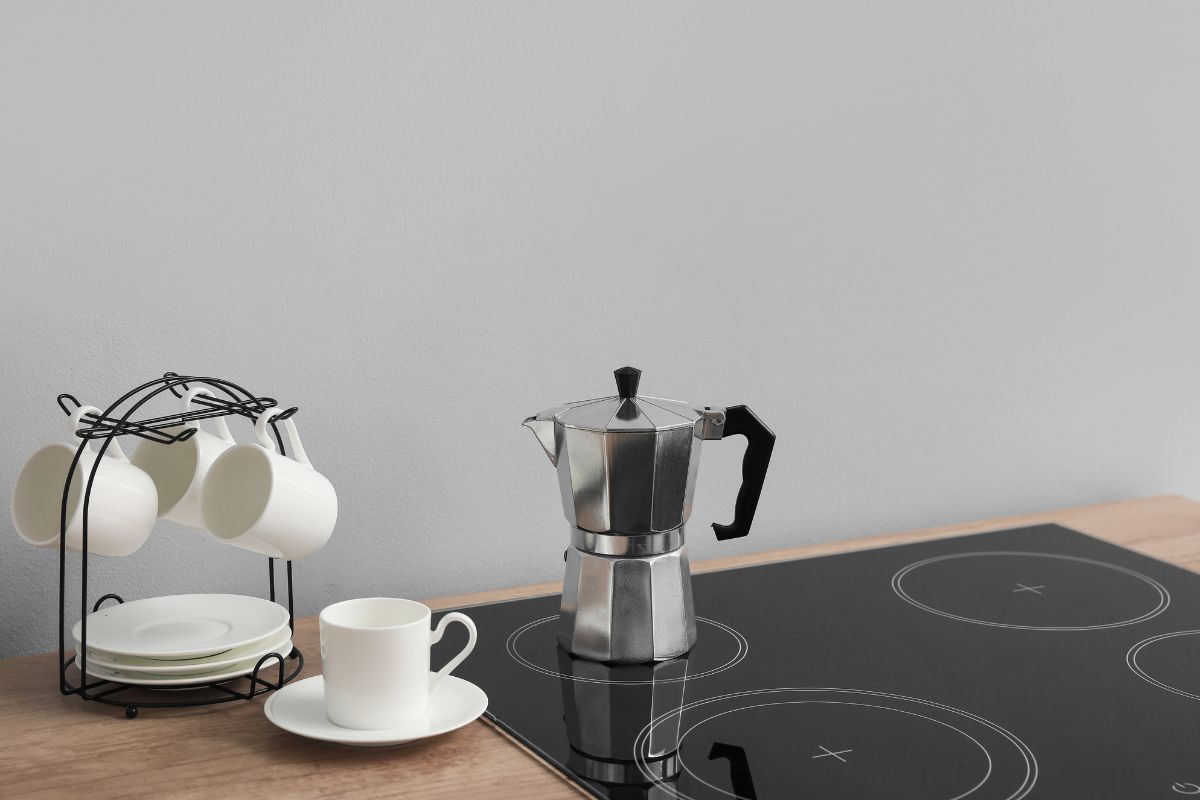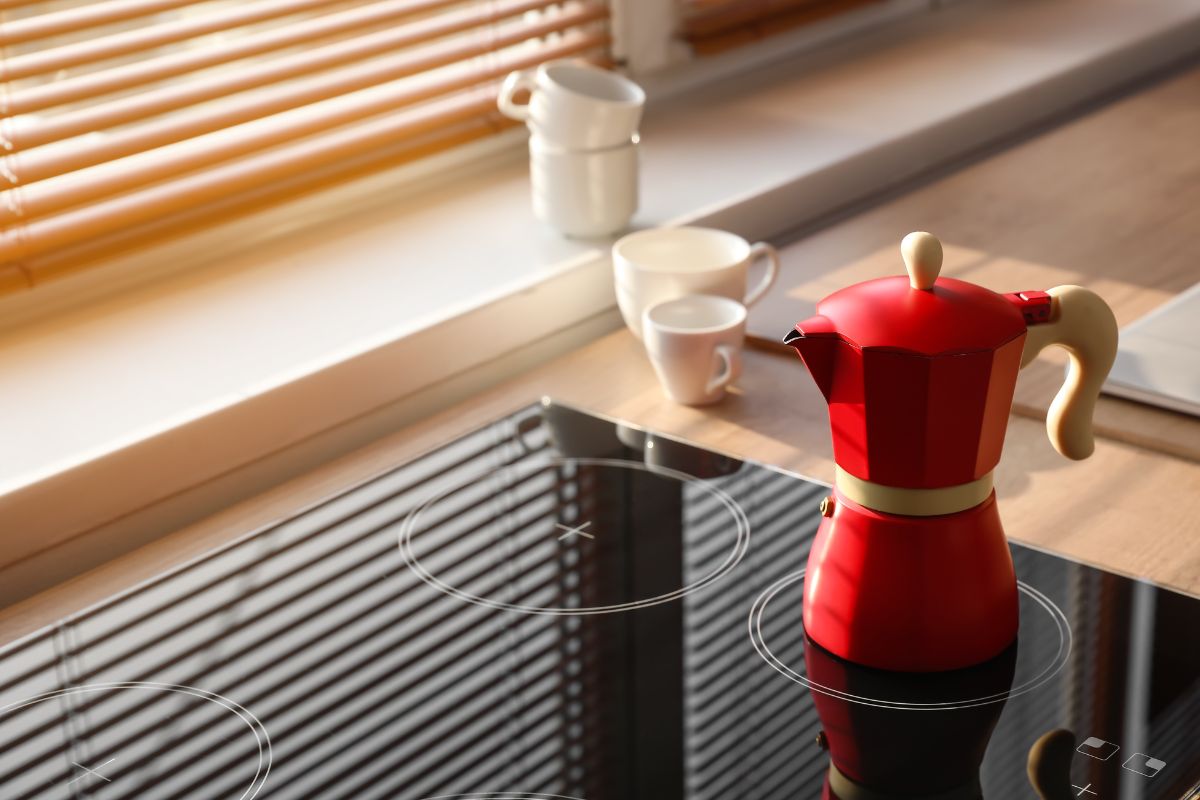The Beauty of Moka Pot Coffee
If you’re a coffee lover, you might have encountered a Moka pot, also called a stovetop espresso maker. So, can you use a Moka pot on an electric stove? These classic Italian brewing devices have gained popularity worldwide due to their ability to create rich and flavorful coffee.
This article discusses the compatibility of Moka pots with electric stoves, highlights Moka pots suitable for electric stoves, and provides useful tips. Let’s dive in.

Can You Use a Moka Pot on an Electric Stove?
The good news is that Moka pots are generally compatible with electric stoves. The design of a Moka pot allows it to work well on various heat sources, including electric stoves.
The bottom chamber of the Moka pot sits directly on the stove’s heating element, allowing the water to heat up and create the necessary pressure for brewing coffee.
Which Moka Pots are Suitable for Electric Stove Use?
Although you can use your Moka pot on an electric stove, it’s generally advisable to always check your Moka pot instructions for compatibility. Here are two types of Moka pots that are suitable for electric stoves:
Aluminum Moka Pots
These pots are the most traditional and commonly used type. They are lightweight, heat up quickly, and provide excellent heat conductivity.
Stainless Steel Moka Pots
These pots are an alternative to aluminum ones. They are durable, resistant to rust, and often have a more modern and sleek appearance.
When selecting a Moka pot for electric stove use, ensure that the pot has a flat and stable base that can make direct contact with the heating element. This ensures efficient heat transfer and optimal brewing conditions.
How to Make Moka Pot Coffee on an Electric Stove
Making Moka pot coffee on an electric stove is a straightforward process that can result in a rich and flavorful cup of coffee. Follow these steps to enjoy a delicious brew:
- Choose the right Moka pot: Select a Moka pot that suits your brewing needs. They come in different sizes, typically ranging from one to 12 cups. Ensure that the Moka pot is compatible with your electric stove.
- Grind the coffee beans: Grind fresh coffee beans to a medium-fine consistency. The grind should be slightly coarser than espresso but finer than drip coffee.
- Fill the bottom chamber: Unscrew the Moka pot and remove the filter basket. Fill the bottom chamber of the pot with cold, filtered water to the pressure release valve or just below it. Avoid overfilling.
- Insert the filter basket: Insert the filter basket back into the bottom chamber. Fill the filter basket with the ground coffee, ensuring it is evenly distributed and leveled. Do not tamp the coffee down.
- Assemble the Moka pot: Screw the top chamber onto the bottom chamber, ensuring it is tightly secured. Be careful, as the bottom section may still contain hot water.
- Preheat the stove: Place the assembled Moka pot on the electric stove. Preheat the stove by turning it to a medium heat setting.
- Brew the coffee: Allow the Moka pot to heat up on the stove. As the water heats, steam pressure will build, forcing the water through the coffee grounds and into the top chamber. You will hear a gurgling sound indicating the brewing process is underway.
- Monitor the process: Watch the Moka pot as it brews. When the top chamber is about three-quarters full, remove the Moka pot from the stove to prevent over-extraction.
- Cool the Moka pot: Place the Moka pot on a heat-resistant surface or run the bottom chamber of the pot under cold water to stop the brewing process and cool down the pot.
- Serve and enjoy: Carefully unscrew the top chamber once the Moka pot has cooled. Pour the coffee into your cups or mugs. Moka pot coffee is strong, so you may dilute it with hot water or enjoy it as is.
Why are Gas Stoves Best for Moka Pot Coffee?
Gas stoves are often considered ideal for brewing Moka pot coffee due to several reasons:
Heat Control
Gas stoves offer better heat control compared to electric stoves. You can adjust the flame intensity with a gas stove to achieve the desired brewing temperature.
This precise control allows you to maintain the optimal heat level for brewing Moka pot coffee, which can contribute to better extraction and flavor.
Direct Flame Contact
Moka pots are well-designed for direct heat sources, and gas stoves provide direct flame contact. The bottom chamber of the Moka pot sits directly on the gas burner, allowing for efficient heat transfer and quick water heating. The direct flame contact ensures the Moka pot reaches the necessary pressure for brewing coffee.
Faster Heating
Gas stoves generally heat up faster compared to electric stoves. This means the Moka pot can reach the desired brewing temperature faster, reducing the brewing time. The shorter brewing time can contribute to a more consistent and flavorful cup of Moka pot coffee.
Uniform Heat Distribution
Gas burners distribute heat more evenly across the bottom of the Moka pot. This even heat distribution promotes uniform extraction of flavors from the coffee grounds, producing a balanced and well-rounded cup of coffee.
Greater Flexibility
Gas stoves offer more flexibility in terms of heat adjustments during the brewing process. You can easily increase or decrease the flame intensity to fine-tune the brewing temperature according to your preferences.
This flexibility allows for greater control over the brewing process, enabling you to customize the flavor and strength of your Moka pot coffee.

The Different Types of Electric Stoves
When it comes to electric stoves, there are a few different types available on the market. Let’s explore some of the common types of electric stoves:
Coil Electric Stoves
Coil electric stoves are one of the most traditional and widely used types. They feature exposed heating elements in the form of coiled metal elements on top of the stove.
The electric current passing through the coils generates heat and transfers it to the cookware placed on top.
Smooth-Top Electric Stoves
Smooth-top electric or glass-top stoves have a flat, ceramic glass surface. Unlike coil stoves, there are no exposed heating elements. Instead, there are heating elements located beneath the glass surface.
The smooth-top design makes cleaning easier and provides a sleek and modern look to the kitchen.
Induction Electric Stoves
Induction electric stoves are gaining popularity due to their efficiency and precise control over heat. These stoves use magnetic fields to generate heat directly in the cookware.
The cookware must be of a magnetic material, such as stainless steel or cast iron, for the induction process to work. Induction stoves heat up quickly, offer precise temperature control, and are energy-efficient.
Infrared Electric Stoves
These are electric stoves that use infrared radiation to cook food. Although infrared radiation is invisible to the human eye, you can still feel the heat. Electric infrared stoves emit infrared radiation from electrical energy, subsequently focused upon the Moka pot. The Moka pot then absorbs the infrared radiation causing the water to boil.
When using a Moka pot on an electric stove, it’s essential to ensure that the stove is compatible with the Moka pot and placed securely on the heating element for safe and efficient brewing.
How Do Aluminium and Stainless Steel Coffee Pots Work?
Both aluminum and stainless steel coffee pots, including Moka pots, use heat and pressure to extract the flavors from coffee grounds. Here’s how each type works:
Aluminum Coffee Pots:
Heat Conduction: Aluminum coffee pots, such as traditional Moka pots, are popular for their excellent heat conduction properties. The bottom chamber of the pot gets filled with water and heated on a stove.
Pressure Build-Up: As the water in the bottom chamber heats up, it creates steam and builds pressure. The pressure forces the hot water through a metal filter basket containing coffee grounds between the bottom and top chambers.
Extraction Process: The pressurized steam pushes the water upwards through the coffee grounds, extracting the flavors and oils. The brewed coffee then rises into the top chamber of the pot.
Stovetop Brewing: The Moka pot is placed directly on a stovetop burner, and the heat from the burner gets transferred to the aluminum pot, causing the water to heat and generate steam pressure.
Stainless Steel Coffee Pots
Heat Retention: Stainless steel coffee pots, including some Moka pots, are well-designed with double-walled construction, providing better heat retention than aluminum pots.
Heat Transfer: The stainless steel coffee pot gets in contact with a heat source, such as a stovetop burner. The heat gets transferred to the bottom chamber, heating the water inside.
Pressure and Extraction: Like aluminum pots, the heated water generates steam and pressure, forcing it through the coffee grounds in the filter basket. The extracted coffee then moves up into the top chamber of the pot.
Durability and Maintenance: Stainless steel coffee pots are known for their durability, resistance to rust, and ease of maintenance. They are often preferable for their longevity and robust construction.
Both aluminum and stainless steel coffee pots work effectively in brewing coffee, but they have a few differences. Aluminum pots excel in heat conduction, resulting in faster brewing times. Stainless steel pots offer better heat retention, which can help maintain the brewing temperature for longer.
When choosing between aluminum and stainless steel coffee pots, consider factors such as heat conductivity, heat retention, durability, and personal preference. Additionally, ensure that the chosen coffee pot is compatible with the heat source you plan to use, whether a gas or electric stove.
Steps to Take When Moka Pot Extraction is Too Fast
If you find that the extraction process with your Moka pot is too fast, resulting in under-extracted coffee, there are several steps you can take to adjust and improve the brewing process. Here’s what you can do:
- Use a finer grind size for your coffee grounds. Finer grounds increase the resistance to water flow, which can slow down the extraction process and allow for better extraction of flavors.
- Tamp the ground coffee in the filter basket before assembling the Moka pot. Tamping increases the resistance and can help regulate the water flow, slowing the extraction process.
- If using a stovetop, lower the heat intensity. Reducing the heat can extend the brewing time, allowing for a more balanced extraction.
- Use preheated water in the bottom chamber of the Moka pot. Cold water can cause the brewing process to start too quickly, leading to a fast extraction.
- Experiment with different coffee-to-water ratios. Increasing the number of coffee grounds or decreasing the water volume can slow down the extraction process and result in a stronger brew.
- Remove the pot from the heat source when the brewing process is complete. This prevents over-extraction and ensures a more balanced and flavorful cup of coffee.
Does the Bialetti Work on an Electric Stove?
Yes, Bialetti Moka pots work well on electric stoves. Bialetti is a well-known and trusted brand that produces high-quality Moka pots. These stovetop espresso makers are compatible with various heat sources, including electric stoves.
The bottom chamber of the Bialetti Moka pot sits directly on the electric stove’s heating element, allowing the water to heat up and create the necessary pressure for brewing coffee.
For this reason, you brew a delicious cup of coffee using a Moka pot on an electric stove.

Key Takeaways
Using a Moka pot on an electric stove is possible and a convenient and enjoyable way to brew coffee. The compatibility of Moka pots with electric stoves allows coffee enthusiasts to savor the flavors of homemade stovetop coffee.
While gas stoves are often the preferred choice for Moka pot brewing, it’s important to note that electric stoves can also produce outstanding results. Following the tips in this text, you can confidently make coffee in a Moka pot on your electric stove and elevate your coffee brewing experience.

